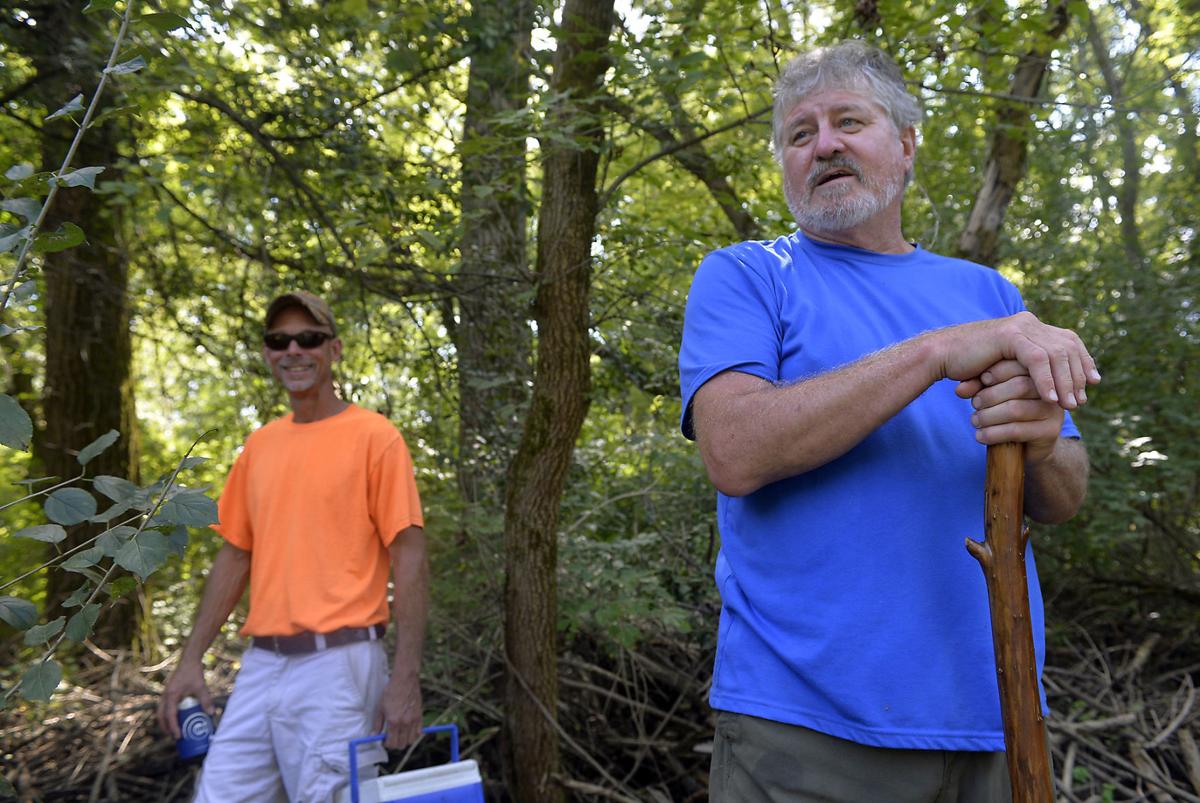
This is a great photo from Kentucky. You know why it’s great? Not because of that cool dam or the fact that you can see it’s leaky because water flows through it. No. Because that culvert is SO damaged anyway, with road collapse and erosion. Look at those dents! It looks about ready to flatten, but the county isn’t worried about that. They are worried about ONE thing. And we all know what that is.
Beavers costing county, landowners Animals threaten roads, crops, timber
They’ve cost the county nearly $100,000 since 2015. They damage cropland and timber. They cause flooding and threaten roads. They are beavers, and they are a growing problem in Hopkins County. Now, a working group under the commissioner of the Kentucky Department of Fish & Wildlife Resources that includes state and federal agencies as well as state and local elected officials is studying the problem.
“They stop culverts up. They stop drainage areas up with sticks and mud,” said Jeff Browning, Hopkins County public works director. “The water backs up and causes damage to roads, crops and woods.” “We start trapping every day, for eight hours a day, in December,” he said. This season, which ended in early spring, county trappers caught 168 beavers, significantly more than the 125-130 they usually get.
“We’re not gaining on it,” Browning said. “And I think it’s getting worse.”
He said his staff is researching multiple approaches, including looking at what other counties and states do, the possibility of setting up conservation-type districts to fund beaver eradication and working with the Corps of Engineers and Division of Water on the legalities involved.
“What I pledged to the group is that I can facilitate finding a solution and working with the counties and Legislature,” Johnson said, adding he expects to have initial information in about 60 days.
Prunty, R-Belton, said she reached out to Johnson after getting multiple letters from constituents in her home county of Muhlenberg. Damage to roads and cropland are not the biggest issue there. Instead, she said, it’s more of a case where former landowners liked the beavers because they created wetlands that attracted waterfowl, which was good for hunters. Now, some landowners want to harvest timber, but can’t because of the flooded land.
“It’s an economic issue for my constituents,” she said. It used to be profitable to trap beavers for their pelts.”There’s no end to it,” Wedding said.”We’ll never eradicate them,” said Browning, the public work director. “I just want some funding help.”
That’s not likely, said Prunty and Embry, R-Morgantown, given the state of the commonwealth’s budget.”I personally don’t see us allocating funds for that,” Prunty said.Embry agreed. Getting new funding “is always difficult,” he said.
Fish & Wildlife Commissioner Johnson said finding funding help is part of his group’s mandate.”We’ll look for other sources of funding that may or may not exist,” he said, indicating some federal help may be available through the USDA. But money won’t solve the problem, which is “how do you keep them under control for the long-term,” Johnson said. “It’s hard to fight those little suckers.“
And as we all know, if something isn’t working or showing signs of success, what you need to do is do it more frequently and faster. Hire more people to kill more beavers because eventually you know it will work right? I mean it’s not like there are these PROVEN tools that will let them protect the roads and culverts and allow the beavers to remain so that they can keep away other beavers right? It’s certainly not like we did it our selves in Martinez for a decade. Better to keep setting the mousetraps over and over and bill the citizens for it. Forget all those disappointed duck hunters.
More complaints from the city of Bristol in Wisconsin where those crazy beavers are just tiring them out.
Beavers causing DAMage in Bristol
Dam(n) it: The phrase describes the beavers’ instincts to build, and with the added ‘n,’ area residents’ reaction to the problems that the large rodents’ work causes in the Dutch Gap Canal.
The dams, removed for decades by residents, were identified at the Bristol Village Board meeting this week as a factor contributing to flooding in the Lake George area.
“We’ve got to get someone out here to trap them,” resident Scott Shannon, said. “It’s a friggin’ nightmare. I’ve taken probably 100 dams out with my (backhoe).”
“Tenfold,” Shannon said. “This is just wearing me out.”
Gosh darn those wicked beavers and their sneaky ways. Why doesn’t killing them work anymore? Don’t tell me there’s another way to solve this problem, because my back hoe is so much fun!
 Marty Johnson, wildlife biologist with the State Department of Natural Resources, confirmed that the beaver population is increasing.
Marty Johnson, wildlife biologist with the State Department of Natural Resources, confirmed that the beaver population is increasing.
“There are more beavers out there,” Johnson said. “The trapping presence over time has lessened, so the population is on the uptick. We have been getting more complaints.”
Johnson said the DNR recently hired the U.S. Fish and Wildlife Service to blow up dams in the public hunting grounds in Wheatland. He said beaver activity at Richard Bong State Recreation Area has increased as well.
Paddock Lake administrator Tim Popanda said beaver were causing problems in the canal that leads to the lake a couple of years ago. There, the village obtained permission from the DNR to trap beaver on DNR property out of season.
The DNR website also offers suggestions, such as putting culvert pipes through the dams, to help mitigate the problems. One such system, called the Clemson Beaver Pond Leveler, was developed at Clemson University in South Carolina. Made mostly from PVC pipe, it allows water to flow through a beaver dam or plugged culvert.
“We are trying to figure out if there is something we can do to minimize it,” Kerkman said.
To that end, the Village Board approved spending $17,600 for an engineering study by Strand Associates to determine how water flows in the neighborhood and identify possible solutions. The study will assume beavers will continue to occupy the Dutch Gap Canal.
I have an idea. Give ME the 17,000 dollars and I’ll tell you how to solve this problem. And it isn’t with a 30 year old invention that will get clogged in a minute. Hire Mike Callahan or Skip Lisle or Amy Chadwick to install a flow device and have them teach you how to do it so you can handle the next 30 yourself. Them sit back and watch your water levels safely maintained and your roads clear and your fish and wildlife population thrive as your beaver population stabilizes.
I’m glad we’ve had this little chat.


 “It was actually my artwork. A little over a year ago I decided to paint animals dressed in Victorian clothes. My very first painting was Mr. Beaverton and I was in love. I saw his personality and profession. (I actually finished him on August 24, 2016 and exactly a year later on August 24, 2017 we released our book!) As I continued to paint the characters, I named them, came up with their jobs, and wrote up the personalities. I decided to feature North American animals (except our hedgehog, which book 1 explains how he got to North America). In September 2016, I approached my sister-in-law (who lives clear across the U.S.) and asked her if she would be willing to write a children’s chapter book based on my characters. She said she’d love to! She was amazing to work with and took the characters and town that I had envisioned and gave them a lovely story. We have 8 books planned and have made a list of problems that animals may experience in the wild and made a long list of things to teach about nature that we hope to sprinkle throughout the series. It’s been such a fun project and I’ve learned even more about nature as I study different animals and whatnot.”
“It was actually my artwork. A little over a year ago I decided to paint animals dressed in Victorian clothes. My very first painting was Mr. Beaverton and I was in love. I saw his personality and profession. (I actually finished him on August 24, 2016 and exactly a year later on August 24, 2017 we released our book!) As I continued to paint the characters, I named them, came up with their jobs, and wrote up the personalities. I decided to feature North American animals (except our hedgehog, which book 1 explains how he got to North America). In September 2016, I approached my sister-in-law (who lives clear across the U.S.) and asked her if she would be willing to write a children’s chapter book based on my characters. She said she’d love to! She was amazing to work with and took the characters and town that I had envisioned and gave them a lovely story. We have 8 books planned and have made a list of problems that animals may experience in the wild and made a long list of things to teach about nature that we hope to sprinkle throughout the series. It’s been such a fun project and I’ve learned even more about nature as I study different animals and whatnot.”













































